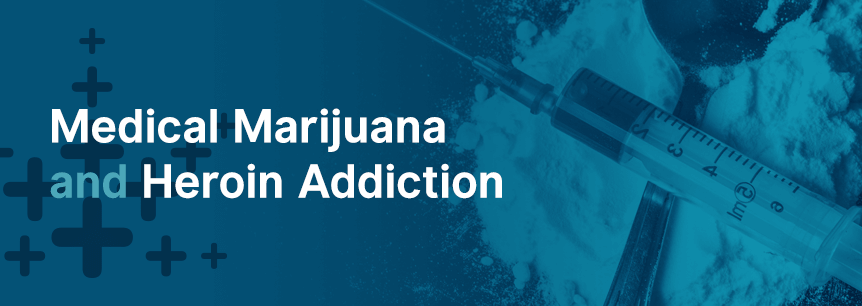
Medical marijuana can treat many conditions that include pain, nausea, reduced appetite and a variety of other symptoms, and it’s also proving to be a viable option to help heroin addicts recover from addiction. To take a step toward recovery and to determine if this treatment is right for you, you can start by understanding how you can use marijuana for heroin addiction.
Heroin comes from the opium poppy and is more potent than morphine, although it comes from the same flower. It is grown in southern Asia, Mexico and Colombia. Since 1924, the drug has been banned from America because it is addictive and presents a high risk of dependency and overdosing. Users can inject the narcotic into their veins, snort it or smoke it. It is often referred to as smack, and it quickly invades the brain and interacts with opioid receptors to create intense feelings of pleasure, which is why it is so easy to develop an addiction to it.
The opioid epidemic in America is frightening because prescriptions for opioid pain relievers can turn into addictions for harder substances. Partly due to the encouragement of pharmaceutical companies, doctors felt free to prescribe high dosages of opioids to treat pain in the 1990s. Because opioids led to addictions, many people either obtained high dosages from their doctors or turned to illegal and more dangerous forms of opioids.
The most staggering part of the opioid epidemic is the number of deaths that it causes across America. In 2015, over 30,000 people died from opioid overdoses, and the numbers have continued to rise in recent years. In 2017, the number of deaths in the U.S. from opioid overdose increased to an estimated 49,068. Even newborns are affected by the opioid abuse of their mothers with neonatal abstinence syndrome. They develop an addiction to opioids in the womb and experience withdrawal in their first few months of life. Withdrawal in newborns causes significant health concerns including seizures.
Heroin activates brain receptors known as mu-opioid receptors (MORs). Chemicals that occur naturally in your body, called neurotransmitters, bind to these receptors to regulate hormone release, pain and general feelings of well-being. When an artificial substance such as heroin binds to and activates these receptors, however, it creates an intense rush of dopamine — a “feel-good” hormone. This throws the body’s natural hormone release out of balance, but because the feelings of pleasure are so strong, it reinforces the drug-taking behavior as the body wants more.
After the “rush” occurs, the body is essentially exhausted, so users experience drowsiness, reduced mental ability, and slower heart function and breathing. If the amount of heroin is high enough, the heart function and breathing can slow enough to be life-threatening or even fatal. The body also develops a tolerance to heroin over time — meaning you need more of the drug to accomplish the same effects — which makes overdosing much easier.
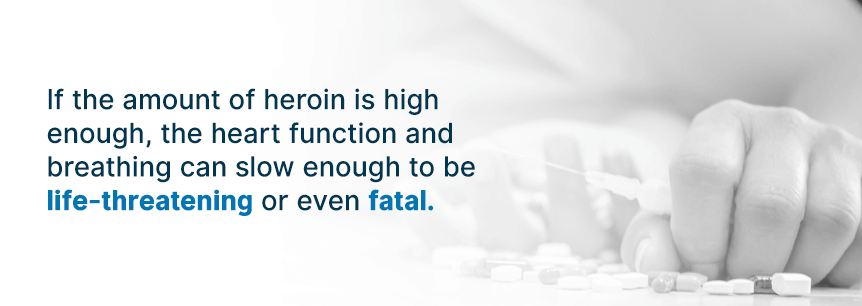
Serious physical effects can occur when people use heroin regularly. Aside from the possibility of overdosing, heroin can have immediate and long-term impacts on your well-being, such as:
There is a connection between prescription opioids and heroin use. Heroin abuse frequently starts with the introduction of opioids for pain relief after surgery or anxiety treatment. Out of first-time heroin users from 2000 to 2013, three out of four misused prescription opioids which led to their use of heroin. Oxycotin, Demerol, Vicodin and Fentanyl are a few of the prescribed drugs that have been linked to heroin addiction.
When prescription opioids enter your body in excessive doses, their effects are similar to those of heroin — which likely explains why users seek out heroin after their prescriptions run out. Heroin is also often easier and cheaper to obtain than prescription drugs.
Currently, for heroin addiction, or heroin use disorder, medications or behavioral methods are the two overarching categories for addiction treatment.
Medications for opioid addictions generally come in three types:
For treatment purposes, some specific medication options are:
The FDA also recently approved a non-opioid medication, lofexidine hydrochloride, under the brand name Lucemyra, to help treat opioid use disorder as part of a long-term treatment plan.
Behavioral therapy can be helpful in both residential and outpatient rehab facilities. There are two main types of therapies for treating heroin addiction:
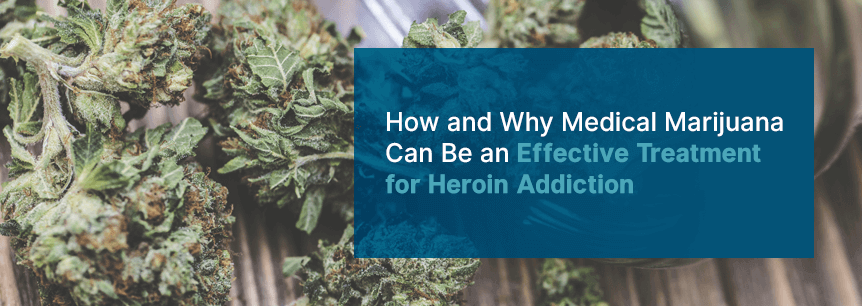
Marijuana is an alternative to opioids that provides similar effects without the high risk of addiction. States that legally recommend marijuana for medical use are also seeing reduced prescription opioid addictions and heroin abuse. When people have access to physician-approved amounts of marijuana for chronic pain and other conditions, they are less likely to overdose on opioids and can still recover from their ailments.
With the advantages and reduced risk that marijuana offers, controlled amounts can benefit patients in a medical setting. The following specific benefits of marijuana can help heroin users get through withdrawal and provide another option for pain relief, anxiety and more:
A common reason people get addicted to opioids is that they get a prescription for them for pain relief. Then, because of the drugs’ potential to create such a rewarding high, they also carry a high risk of addiction. Once people can no longer get or afford their prescription opioids, they might turn to heroin, which is often less expensive and easier to obtain.
Marijuana, however, has also proven to be effective at relieving pain — whether it is chronic pain or that resulting from another disease — and it isn’t addictive like opioids can be. If doctors still prescribe opioids for the particular condition they are treating, combining it with a medical marijuana regimen often means a much lower dose of opioids is necessary, which further reduces the risk of addiction. Several cases show a successful reduction of opioids like morphine after the introduction of medical marijuana.
Opiate withdrawal symptoms range in severity, duration, and type, depending on how long the person has been using the drug. However, some of the most common include:
With the various cannabinoids present in marijuana, particularly tetrahydrocannabinol (THC) and cannabidiol (CBD), medical weed can provide relief for many of heroin’s withdrawal symptoms. CBD has a calming effect, and it does not produce a high. THC is responsible for the euphoric effects marijuana can have. Different strains of cannabis possess various ratios of THC to CBD, so the correct one will vary based on symptoms and their severity.
While you can overdose on heroin, there have been no deaths reported from overdosing on marijuana. You would need to ingest at least 1,500 pounds of marijuana in 15 minutes — either by smoking, eating or using an oil form — for a lethal dosage, and that is, of course, impossible for any human. Even overdosing on over-the-counter pain reliever like acetaminophen can occur with lower dosages than that.
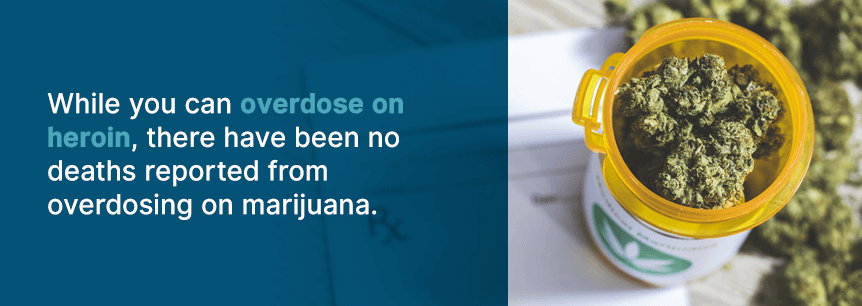
Those who choose medical marijuana for their heroin addiction and as a way to get through withdrawal have virtually no risk of overdosing with this treatment. Adding pot to the treatment plan is similar to other partial agonist medications and can provide relief from severe withdrawal symptoms. Since marijuana activates the same opioid receptors as heroin, it produces the same effect as heroin but not as intensely. Additionally, higher amounts of a partial agonist, such as medical cannabis, do not provide more intense feelings of pleasure. Over time, this can effectively stop a person from craving heroin altogether.
While less severe than those of heroin and other opioids, medical marijuana does have some possible side effects. The following effects and risks of medicinal cannabis can happen over time and be heightened with previously existing conditions:
The strains that work best for heroin addiction will vary depending on the symptoms you are experiencing. For example, if anxiety is prevalent, a strain with a high THC percentage won’t be very beneficial. Sativa strains tend to increase energy and create a euphoric effect, but they can increase feelings of anxiety. Indica strains tend to create a relaxed feeling and are ideal for promoting sleep.
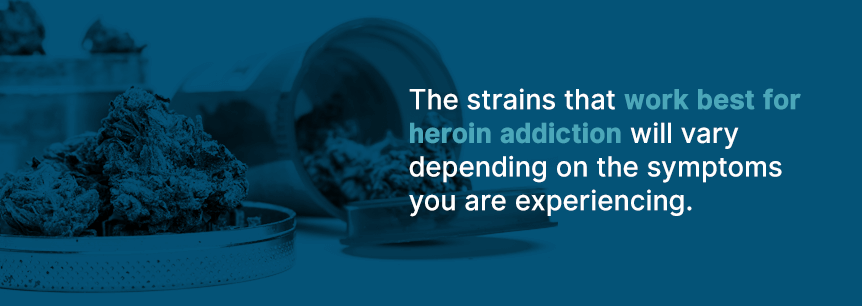
You will want to work with your marijuana doctor to determine exactly which varieties will be best for your symptoms, but here is a closer look at just a few of the strains that can help provide relief for common heroin withdrawal symptoms:
OG Kush is beneficial for those experiencing heroin withdrawal because it can alleviate stress, depression, pain, and insomnia.
Girl Scout Cookies is a strain that helps addicts through the pain, altered appetite and headaches they may experience.
The Northern Lights strain assists heroin addicts with relieving stress and sleep issues. Insomnia, pain and lack of appetite are all aided by this strain.
As a Sativa strain, Super Sour Diesel is energizing and is best used during the day to provide relief from stress, depression, headaches, and nausea.
If you or someone you love wants to overcome a heroin addiction, medical marijuana can aid in that journey. Cannabis, in the correct doses, can be an effective method to fight dependency and protect you from overdosing. For those who started taking opioids to relieve pain, medical marijuana is a viable medicinal product.
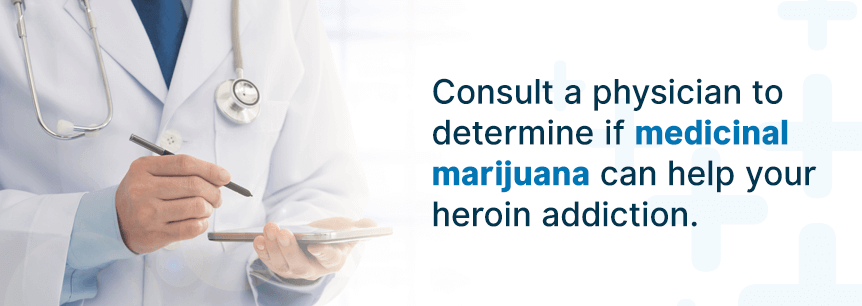
Consult a physician to determine if medicinal marijuana can help your heroin addiction. Doctors who are legally authorized to recommend marijuana can guide you through the risks, benefits, and considerations of cannabis. MarijuanaDoctors.com can assist you in finding a medical marijuana doctor and locating a dispensary. You can also find information on which states have legalized medical cannabis, requirements to obtain a medical marijuana card and other resources.
Find A Doctor Find A Dispensary